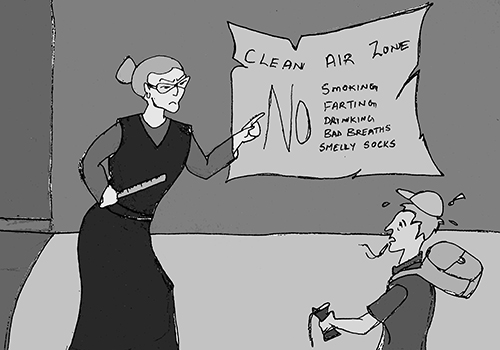Portland State has accepted the regional Fresh Air Campus Challenge posed by local, state and federal health authorities. Building on the campus’ current Clean Air Corridor, the challenge is to eliminate all smoking on PSU’s campus by 2016.
Smoke-free by 2016

Portland State has accepted the regional Fresh Air Campus Challenge posed by local, state and federal health authorities. Building on the campus’ current Clean Air Corridor, the challenge is to eliminate all smoking on PSU’s campus by 2016.
If the ban is implemented, PSU would join more than 60 other colleges in the Pacific Northwest with campus-wide smoking bans, including Oregon State University, the University of Oregon, Oregon Health and Science University and 50 community colleges statewide. Nationally, 17 percent of all campuses have implemented anti-smoking policies.
The logic behind such bans and policies is that barring students from performing the unhealthy act on campus will compel a complete behavioral change. In other words, by not being allowed to indulge in an unhealthy habit on campus, where students may spend a majority of their day, they will eventually quit the habit altogether.
In an interview with Oregon Public Broadcasting, former Portland Community College student Hannah Muller claimed that a similar ban at PCC allowed her to view her smoking habit as diverging from social norms and compelled her to quit. So others will quit, too, right?
While no one would argue against the health concerns involved with tobacco use, is it really up to the university to control its students’ behavior outside of the classroom? I suppose that they reserve the right to do so on campus property, but this ban reminds me of “babysitter” policies such as seatbelt laws. Performing the action (smoking or not wearing a seatbelt) doesn’t truly harm anyone else.
These policies are put in place with the assumption that people can’t take care of themselves and that money can be made off this “inability” through fines and tickets.
There are many other unhealthy behaviors and health risks that affect college students, most of which affect more students than smoking does, and many are as (if not more) dangerous to your health than smoking. Why is the university so fixated on eliminating smoking, yet able to look the other way in regard to other health risks?

Despite its indisputable health risks, smoking is a right. It isn’t illegal, so why do we treat smoking like it’s the most deviant act a person can perform in public? If smoking bans are put into effect, then we should continue that line of thinking: We should ban junk food, fast food chains and soda on campus. We should ban alcohol and its sale on campus. We should ban drinking more than one cup of coffee per day. Physical education courses should become a prerequisite for graduation.
The American College Health Association’s 2012 National College Health Assessment shows that 64.9 percent of college students nationwide used alcohol within 30 days of the survey; 34 percent of college students ranged from overweight to type III obesity; 11.6 percent were professionally diagnosed with anxiety; 10.6 percent were professionally diagnosed with depression; 44 percent of students never wear a helmet when biking; 21.1 percent reported doing no moderate cardio or aerobic exercise on a weekly basis; 35.9 percent reported doing no vigorous cardio or aerobic exercise on a weekly basis.
But only 6.8 percent claimed to smoke tobacco 10 or more days a month. A simple analysis shows that smoking isn’t even the biggest health risk to college students. Why, then, are we treating it as such?
If we take the logic behind the smoking ban down its natural course, we can see how ridiculous it becomes. With the Clean Air Corridor,we’ve already banned smoking in areas with a high likelihood of secondhand smoke inhalation, which is commendable, but let the rest be.
The school shouldn’t try to control every student’s personal decisions. That is, they shouldn’t pick and choose which health risks to control and which to ignore, especially when problems like alcohol use and physical inactivity pose a much greater threat to a healthy student population.







“Performing the action (smoking or not wearing a seatbelt) doesn’t truly harm anyone else.”
Secondhand smoke?! Even with the “Clean Air Corridor”, I am blasted by noxious fumes on a daily basis. Smoking on campus violates the rights of those who don’t want to be forced to inhale lung-blackening carcinogens. Smoke in your yard or in a secluded place, if you must.
I could go on and on about this, but I’ll leave it at that.
Did you seriously write that “smoking … doesn’t truly harm anyone else”? Are you kidding? Second-hand smoke poses a considerable and often deadly risk to anyone who comes in contact with it, particularly if they’re like me and are allergic to toxins in the smoke over and above the standard risks of breathing things like arsenic. I’ve been hospitalized because some inconsiderate smoker started smoking at a bus stop and I didn’t notice in time. Without enforced clean-air policies regarding the corridors between PSU buildings I have to worry about my personal health and safety any time I step outside to walk between classes. I constantly have to hold my breath or cover my nose and mouth to avoid other people exercising their “right”.
The fact that you call smoking a “right” not only demonstrates your callous lack of regard for the others that it harms, but your complete and utter lack of understanding of civic rights themselves. Anyone with the power to write for a school newspaper ought to at least know that one’s right to swing one’s arms ends where the other man’s nose begins (thank you Zechariah Chafee). Sure, you have the “right” to smoke. You also have the right to own a gun, and even to go to a shooting range and fire it. But taking your gun out in public and firing it off randomly in every direction is unacceptable, yet that’s exactly what your doing when you smoke in public.
I think it’s stupid for PSU to regulate its students’ -legal- behavior in the first place, but this really won’t do anything because PSU is an urban campus. You barely have to walk at all to get off the campus and into the rest of the city–where PSU has no authority to ban smoking. I don’t think that they can even ban it in the parkblocks.
Well folks perhaps you should do far more research than you have in regards to the effects of 2nd hand smoke and how many people die from it in the US alone. It is ludicrous in this day and age for anyone to say an individual smoking only harms the individual. Not to mention what the cigarette butts do to our environment. What about setting an example for others? Do you want others to die a long with you and pick up this life dibilitating habit?! Most smokers will never live as long as they could and even if they do they will likely be living with many detrimental health effects. In fact smokers are dying younger and younger and at an alarming rate.While you are at it read about how the Phillip Morris company is targeting students as its replacement smokers for the thousands that are dying every day. The university has a responsibility to protect all of its students. Tobacco is now the #1 killer. It is not baby sitting. It is saving lives. Wow not so small of a matter after all. Why not start today, it sounds like the smartest decision you will ever make. NOT.